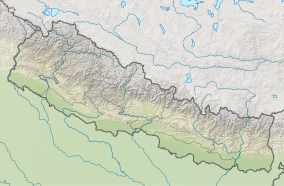
Back Taman Nasional Parsa BAN পর্সা জাতীয় উদ্যান Bengali/Bangla पर्सा वन्यजन्तु आरक्ष DTY Parque nacional de Parsa Spanish Parsan luonnonpuisto Finnish Riserva naturale di Parsa Italian पर्सा वन्यजन्तु आरक्ष MAI पर्सा राष्ट्रिय निकुञ्ज Nepali Rezerwat Przyrody Parsa Polish ᱯᱟᱨᱥᱟ ᱡᱟᱹᱛᱤᱭᱟᱹᱨᱤ ᱯᱟᱨᱠ SAT
| Parsa National Park | |
|---|---|
 Indian pitta at Parsa National Park | |
| Location | Nepal |
| Nearest city | Birgunj |
| Coordinates | 27°28′N 84°20′E / 27.467°N 84.333°E |
| Area | 627.39 km2 (242.24 sq mi) |
| Established | 1984 as Wildlife Reserve, 2017 as National Park |
| Governing body | Department of National Parks and Wildlife Conservation |
 | |
Parsa National Park is a national park in the Terai of south-central Nepal covering an area of 627.39 km2 (242.24 sq mi) in the Parsa, Makwanpur and Bara Districts and ranging in elevation from 435 to 950 m (1,427 to 3,117 ft) in the Sivalik Hills. It was established as a wildlife reserve in 1984 and received national park status in 2017. It is surrounded by a buffer zone since 2005 with an area of 285.3 km2 (110.2 sq mi).[1] In 2015, the protected area was further extended by 49 sq mi (128 km2).[2]
To the north of Parsa National Park, the East Rapti River and Sivalik Hills form a natural boundary to human settlements. To the east, the boundary extends up to the Hetauda–Birgunj highway; to the south, a forest road demarcates the park's boundary. To the west is Chitwan National Park, which is situated just north of Valmiki National Park, a tiger reserve in India. Thus, this transnational protected area of 2,075 km2 (801 sq mi) represents the Tiger Conservation Unit (TCU) Chitwan–Parsa–Valmiki, which covers a total of 3,549 km2 (1,370 sq mi) in the Terai–Duar savanna and grasslands.[3]
Before being converted to a protected area, the region was a private game reserve and hunting park for both the British and Nepalese elite.[1][4]
- ^ a b Bhuju, U. R.; Shakya, P. R.; Basnet, T. B.; Shrestha, S. (2007). Nepal Biodiversity Resource Book. Protected Areas, Ramsar Sites, and World Heritage Sites (PDF). Kathmandu: International Centre for Integrated Mountain Development, Ministry of Environment, Science and Technology, in cooperation with United Nations Environment Programme, Regional Office for Asia and the Pacific. ISBN 978-92-9115-033-5. Archived from the original (PDF) on 2011-07-26. Retrieved 2018-12-14.
- ^ Anonymous. 2015. Good news for tigers as Nepal extends Parsa Wildlife Archived 2018-07-09 at the Wayback Machine. Wildlife Extra, 9 September 2015.
- ^ Wikramanayake, E.D., Dinerstein, E., Robinson, J.G., Karanth, K.U., Rabinowitz, A., Olson, D., Mathew, T., Hedao, P., Connor, M., Hemley, G., Bolze, D. (1999). Where can tigers live in the future? A framework for identifying high-priority areas for the conservation of tigers in the wild. Archived 2012-03-10 at the Wayback Machine In: Seidensticker, J., Christie, S., Jackson, P. (eds.) Riding the Tiger. Tiger Conservation in human-dominated landscapes. Cambridge University Press, Cambridge. hardback ISBN 0-521-64057-1, paperback ISBN 0-521-64835-1. Pages 255–272 "Archived copy". Archived from the original on April 6, 2012. Retrieved 2012-03-10.
{{cite web}}: CS1 maint: archived copy as title (link) - ^ Majupuria, T.C., Kumar, R. (1998) Wildlife, National Parks and Reserves of Nepal. S. Devi, Saharanpur and Tecpress Books, Bangkok. ISBN 974-89833-5-8. Pages 245–248.
© MMXXIII Rich X Search. We shall prevail. All rights reserved. Rich X Search
